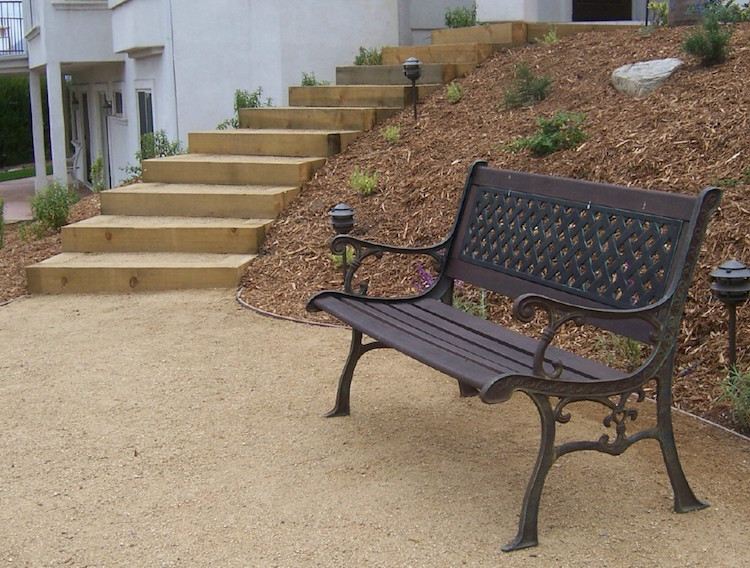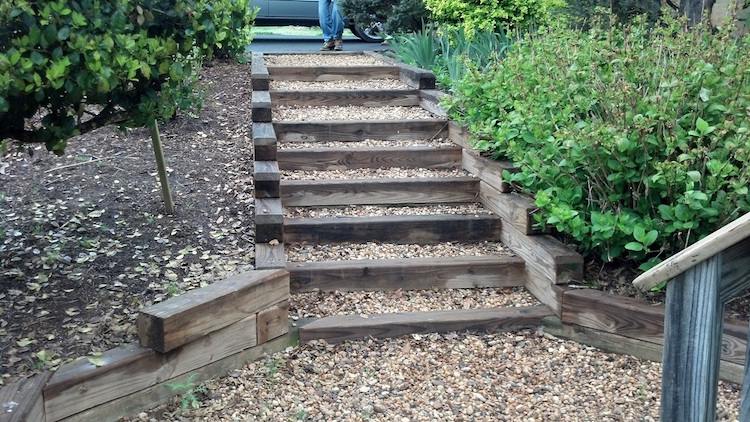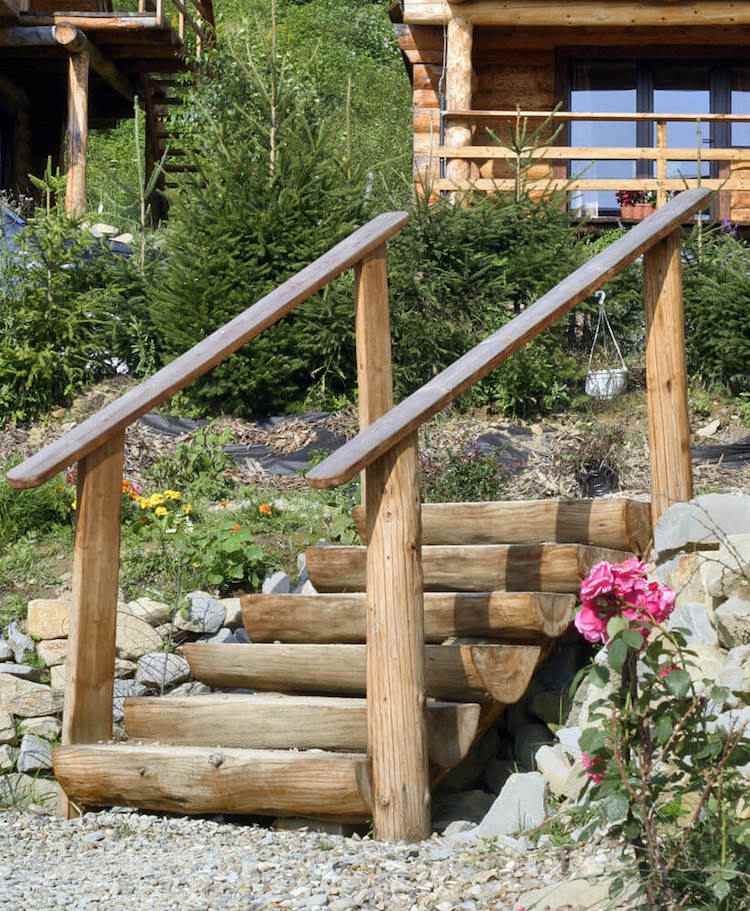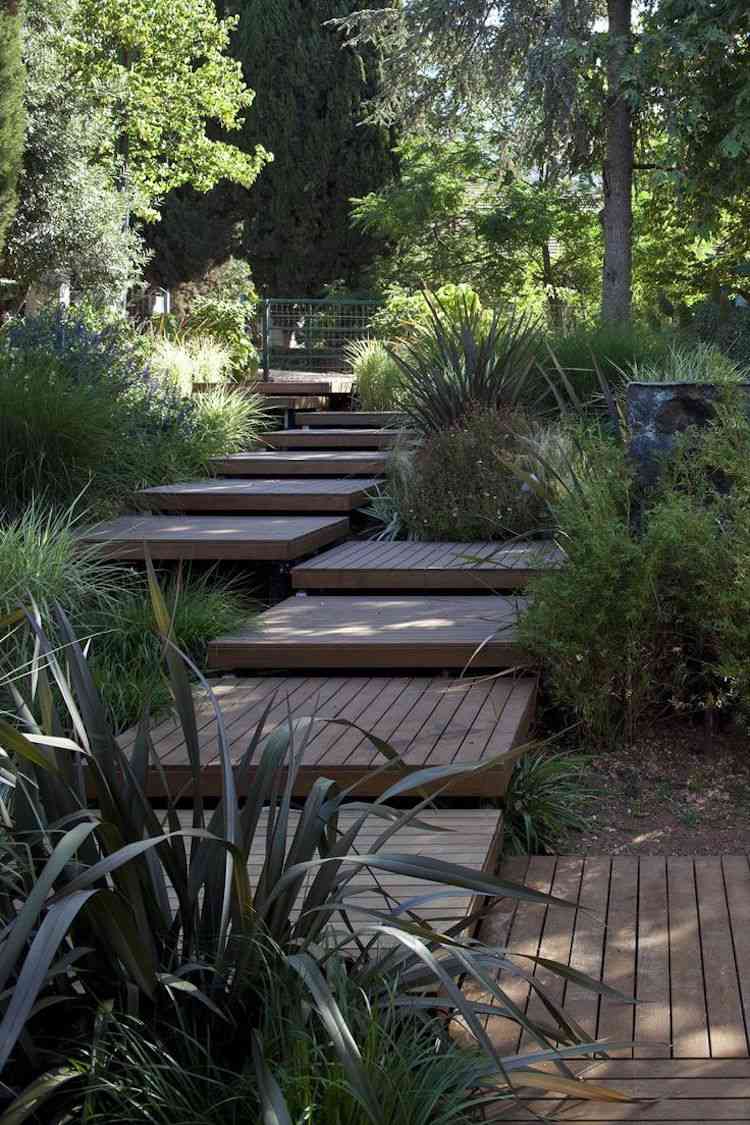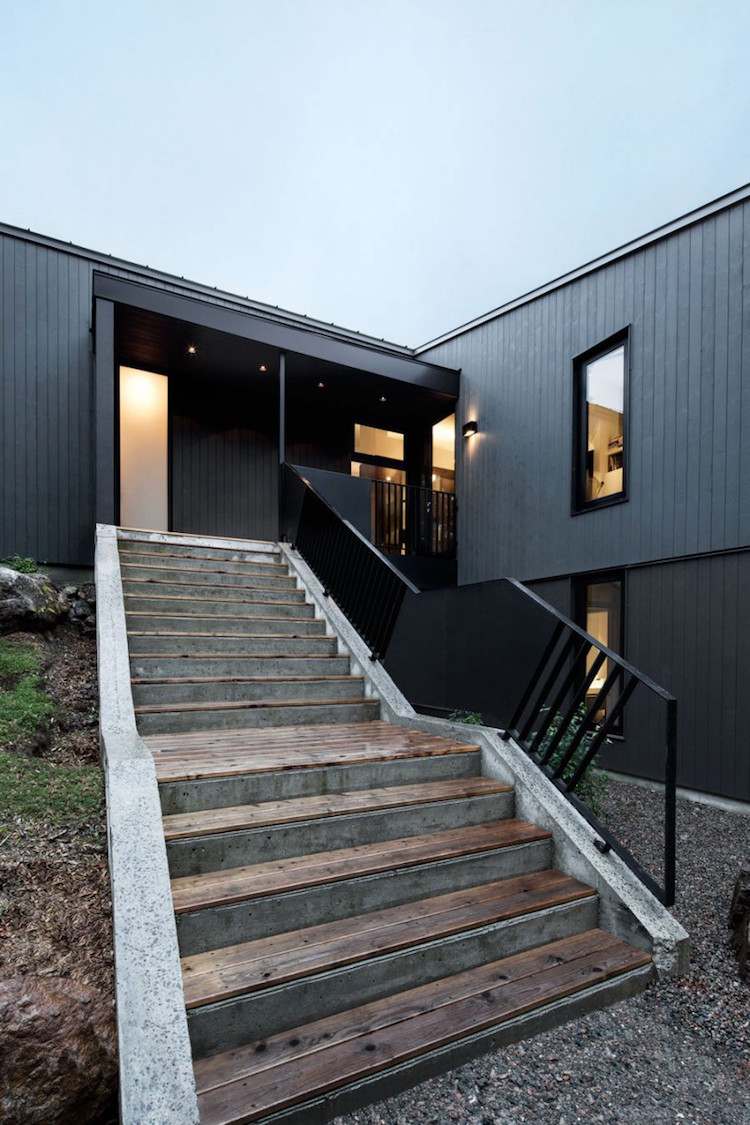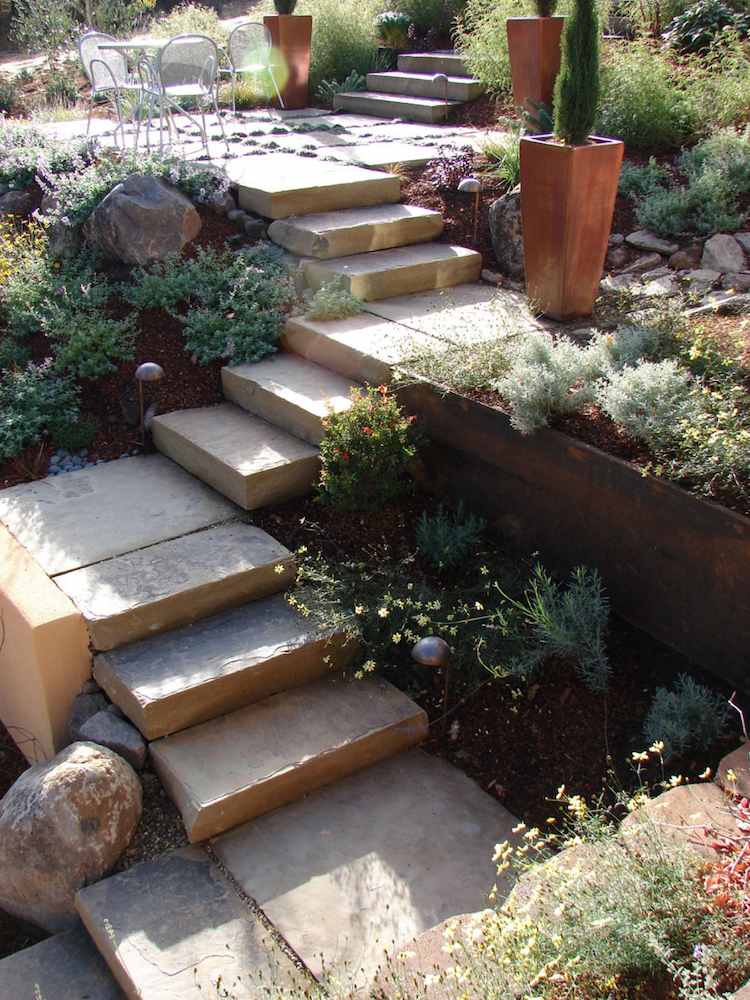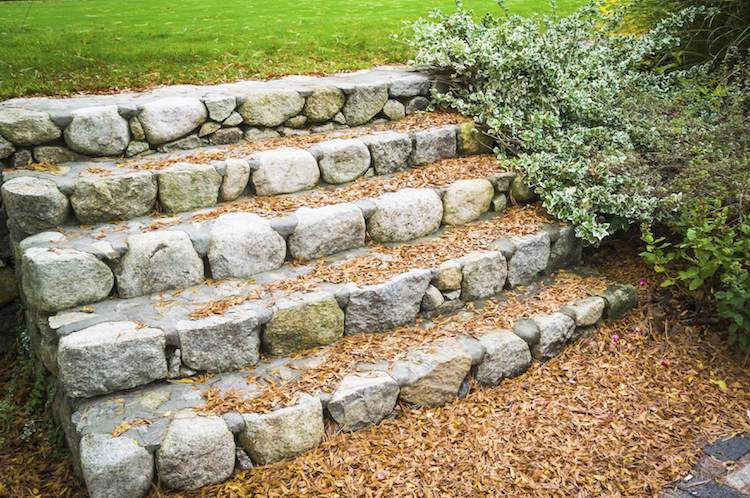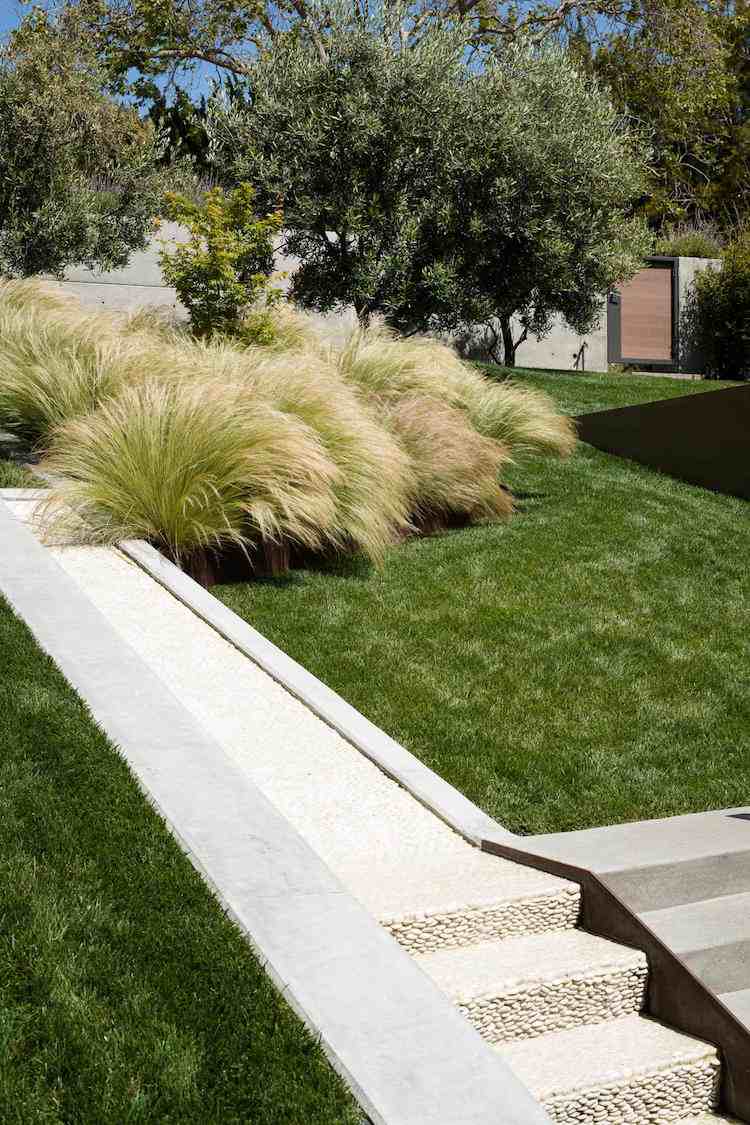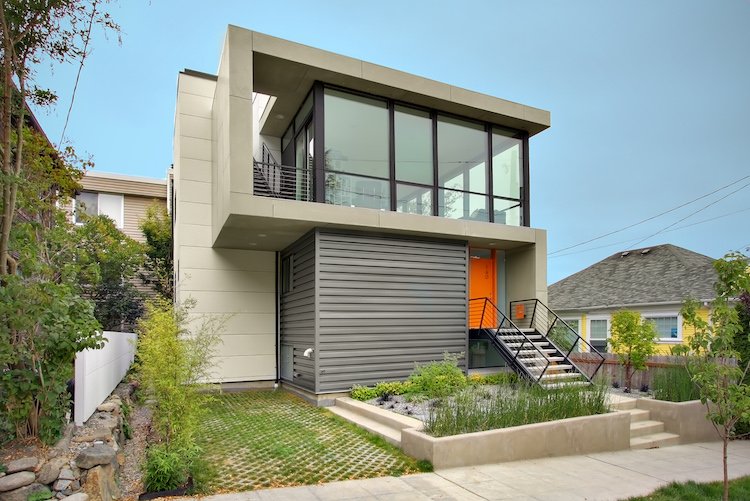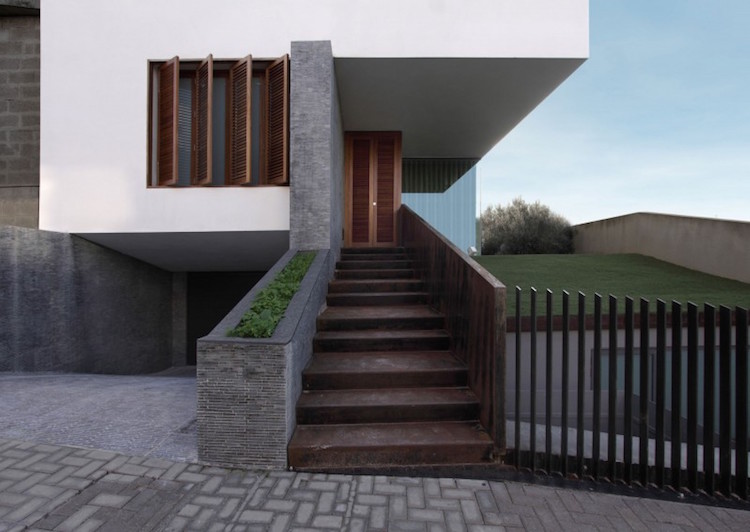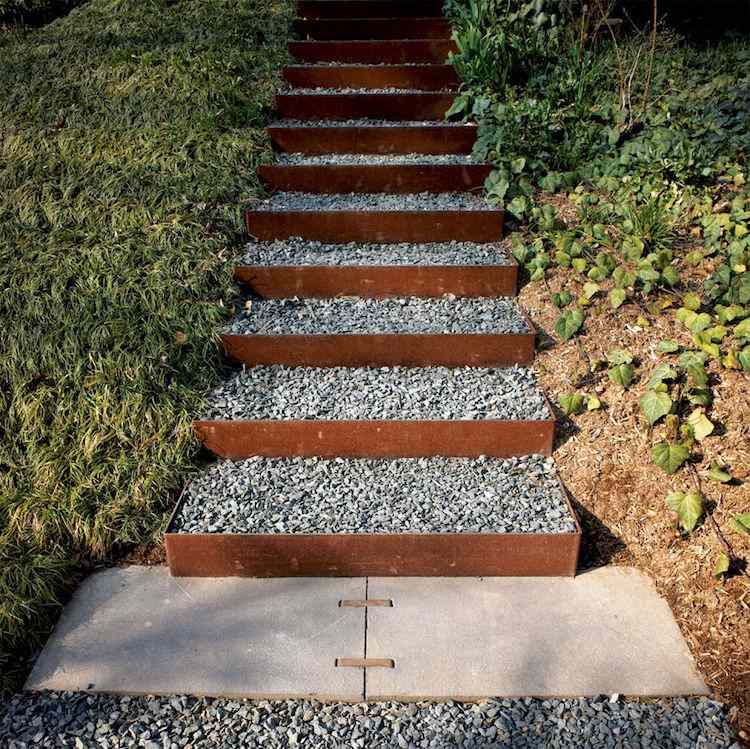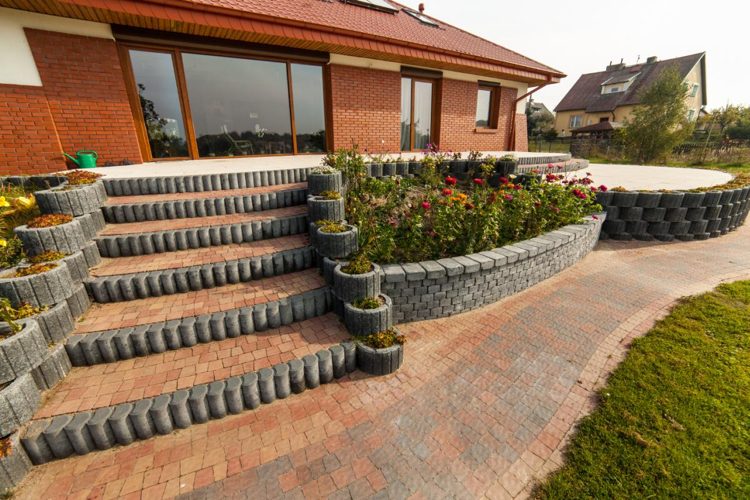A cheap way to make steps on a slope. Stairs in the garden - creating decoration for uneven terrain
Garden stairs not only make it easier to move around the site, but also give the garden a feeling of completeness and structure. If you are thinking about building your own garden stairs, there are a few things to consider. This will be discussed in this article.
Not every staircase can be built without knowledge and experience in this field. Certain structures require a serious foundation, the preparation of which only professionals can do. Therefore, to build garden stairs with a height of more than one meter, it is recommended to either hire a specialist or buy a ready-made staircase made of wood or metal, which you only need to install.

In general, when building a garden staircase, the following rules must be observed: next principle: steps are dug in the ground, a concrete foundation is poured inside, steps made of the selected material are placed on it. The choice of material for a garden staircase depends on its purpose.
What materials are garden stairs made of?

Concrete, brick, paving stones, natural stone are the favorite and most durable materials for construction on outdoors. Wood or wood is also used for the construction of garden stairs. metal constructions. Moreover, metal can be used to make the entire staircase, and it can also serve only as a frame to give stability, for example, to a wooden staircase.
The simplest version of a garden staircase

The simplest option for building a garden staircase, which does not require serious effort (including a foundation), is to drive planks into the ground as risers, filling the space between the risers with crushed stone. The crushed stone will serve as steps. Of course, this option is as simple as it is short-lived.
Construction of a garden staircase that will serve you faithfully for many years

A durable garden staircase consists of a concrete foundation, stone steps and risers. The foundation plays a determining role in how stable and durable your staircase will be. Risers can be made of brick, concrete or paving stones, the space inside of which is filled with crushed stone. Steps made of sandstone, slate, etc. are placed on top. and fixed with cement.
Combining materials when building a garden staircase
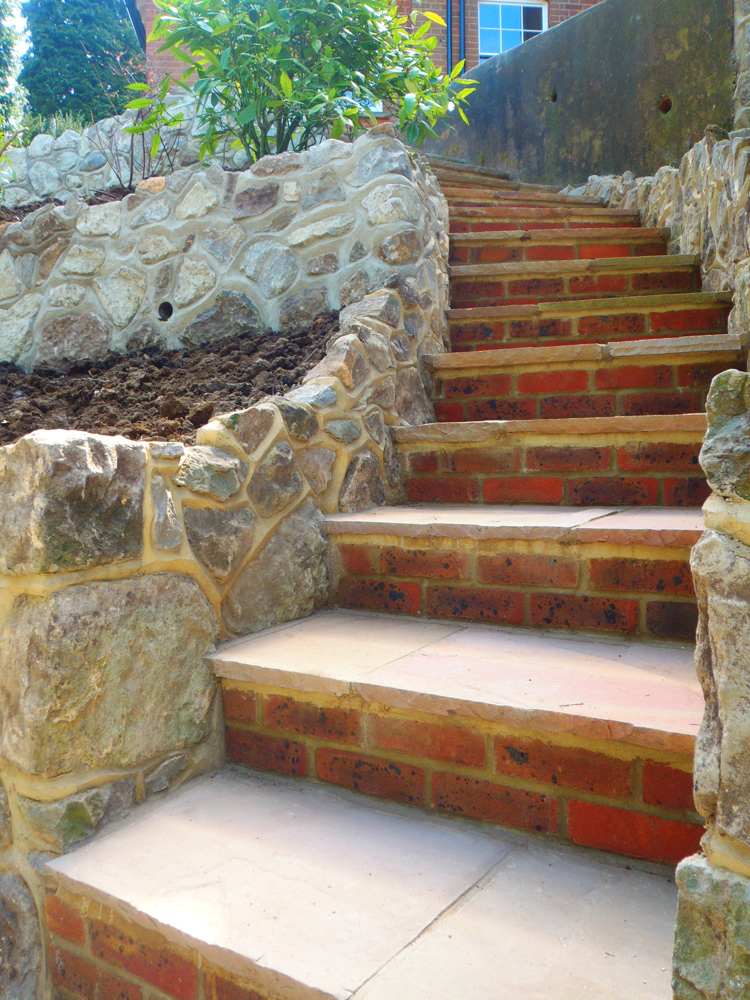
When building a garden staircase, you can successfully combine various materials, and new technologies in construction provide us with various designs, with the help of which it is quite easy to independently build this work of construction art. However, knowledge and experience in this area can make your stairs more durable and, most importantly, safer. Before the beginning construction work Consult an expert who can give you some practical advice regarding your specific project.
DIY garden staircase options
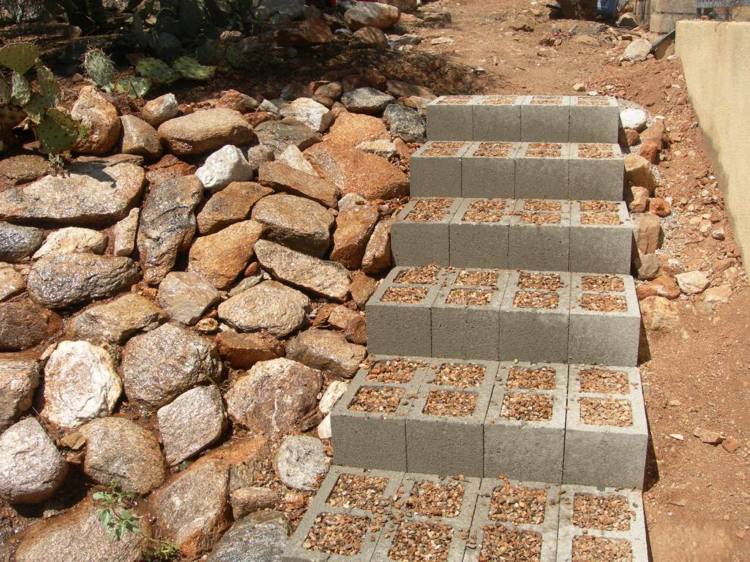
Wooden garden stairs
Stone garden stairs
Concrete garden stairs
Garden stairs made of various materials
Metal garden stairs
Garden staircase made of paving stones
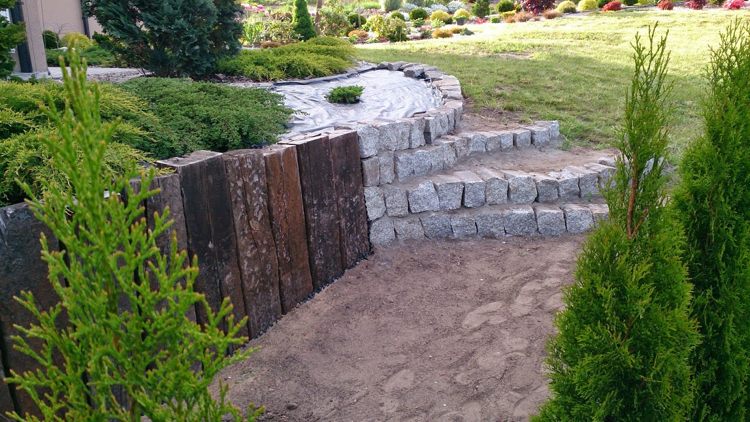
There are dacha plots that have very uneven terrain. Leveling the ground on a slope can be very difficult. But this is by no means a disadvantage if you use a little imagination. Did you get a plot with a slope? Do not despair! My friends, today we’ll talk about how to make steps and stairs in the garden.
I also planned steps on my site, because... we have it. Lots of ideas! Oh I'll turn around!!! In this article I will tell you what material the steps are made of, how to calculate the size of the steps and much more!
On our own stairs and steps Of course, they carry an important functional load in the garden - they connect the multi-level zones of the site with each other. The dimensions used for the construction of stairs inside and outside the house are somewhat different from those used for garden stairs.
Width of garden stairs usually depends on the width of the tracks that it connects with each other. It is worth noting, however, that it is better to have wide, gentle stairs in the garden, since a steep and narrow approach can pretty much ruin your walk through the garden.


Garden staircase should not be very long. If the slope is quite steep, it is better to build a structure with several “rest areas”. This will make climbing (walking) easier and add charm to the garden landscape.

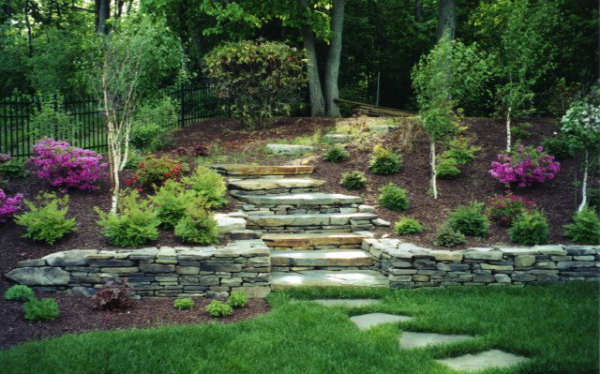
Materials for garden stairs a wide variety of materials are selected: natural stone, brick, concrete blocks or monolithic concrete, wood. Or a combination of these materials. But the determining factor should be the overall style of the house or garden. Let's say a wide granite staircase leading to a modest wooden house It looks, to put it mildly, ridiculous. Remember this!
For those who prefer modern design, it is better to choose concrete: artificial concrete slabs are now produced in a variety of colors.
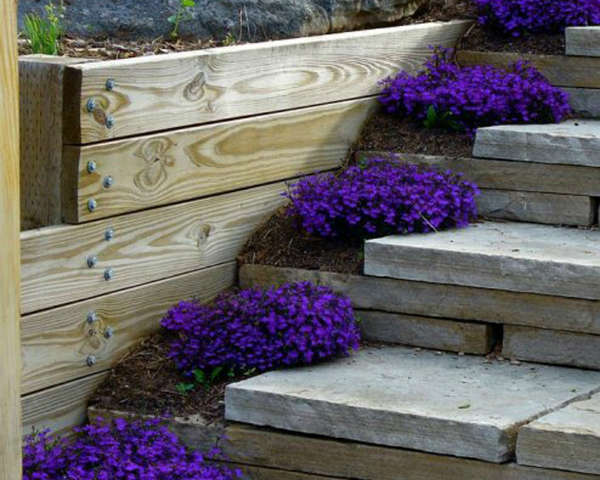

Availability and security- the main points that should be paid attention to when constructing stairs. They must be reliable in any weather. In areas that tend to be shady and damp, make the stairs out of stone or concrete slabs with a special rough surface. My boys, like any other children, of course, love to run up the stairs. So, those who have children should especially take this into account.
Construction of a garden staircase.
— First you need to calculate how many steps the staircase will have, calculate their height and length. Let's find out! The length of a person’s step is approximately 62-64 cm, and a comfortable rise of the leg is 30-32 cm. Based on this, the tread and rise are determined as follows: 2a + b = 64 cm or a + 6 = 47 cm, where a is the height of the step , b - step width.
— On the slope you need to mark the contours of the steps. This can be done by anyone bulk material, for example, cereals, flour. Then you need to remove the top layer of soil. It is important not to forget about a slight slope to drain rainwater.
— We construct formwork from boards that follows the contours of the future staircase, according to existing calculations and measurements. Having installed the boards, you need to drive them into the ground a little by tapping them with a hammer. Don't forget to check the correct placement of the formwork using a building level.
— A bar should be placed along the front edge of each step so that it can be seen how to make stairs in the garden. Then the ground under the future steps must be thoroughly compacted; you can fill it with crushed stone or bricks.
— Then a cement solution is made (one part cement plus four parts sand), mixed thoroughly, with the gradual addition of water until a homogeneous mass is obtained. Then crushed stone is added to the mass, and everything is thoroughly mixed again.
— When the solution is ready, the base of the steps needs to be moistened. Having poured the solution, it needs to be pierced, so to speak, with a shovel, so that there are no voids left. Then you need to level the mixture with a lath with smooth edges (rule).
— Leave the structure for a day until it hardens completely. The formwork can be removed and the edges of the stairs can be decorated with stone or wood.
As you can see, making a staircase in the garden yourself is not at all difficult.
The staircase is ready! You can decorate it by giving it a slightly “aged look” so that it blends into one with the landscape of the site. Harmony is needed everywhere!
Flowering steps on the site.
Having built the steps, it is necessary to give them a finished look so that they finally, so to speak, fit into the landscape of the garden. Let's look at a few ways to help decorate your wonderful staircase.
1. For example, you can decorate the spaces between the steps (risers) with plants. Skillful use of this technique will help not only fit them into any landscape, but will also make such stairs the best decorative elements garden The range of plants used in our conditions is not very wide, but if you wish, you can choose something. Here, for example, several types of sedum are suitable. And of course, friends, adjustments must be made for local operating conditions.

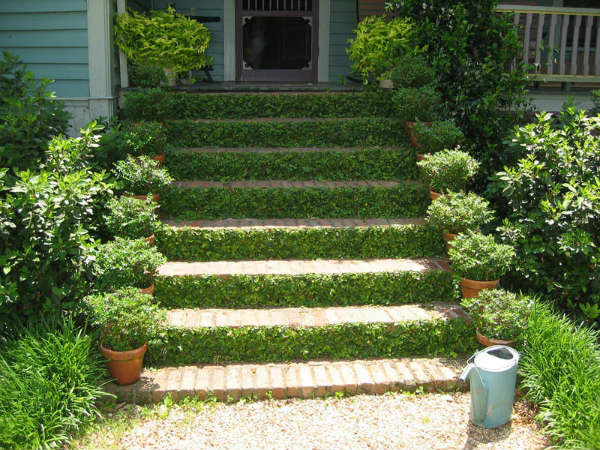
It is clear that you cannot blindly copy what is shown in the photo. The design of steps for Russia with its snowy winters should be somewhat different. But we are talking about general principles!
2. Plant plants along the edges of the steps: creeping speedwell, different kinds and varieties of primroses, tomentose carnival, seaside armeria, mountain chickweed, aubrieta, Carpathian bellflower, various carnations, three-lobed liverwort, saxifrage, awl-shaped phlox - that’s just short list low-growing flowers. Heathers and lavender (dwarf) look stunning near the steps.
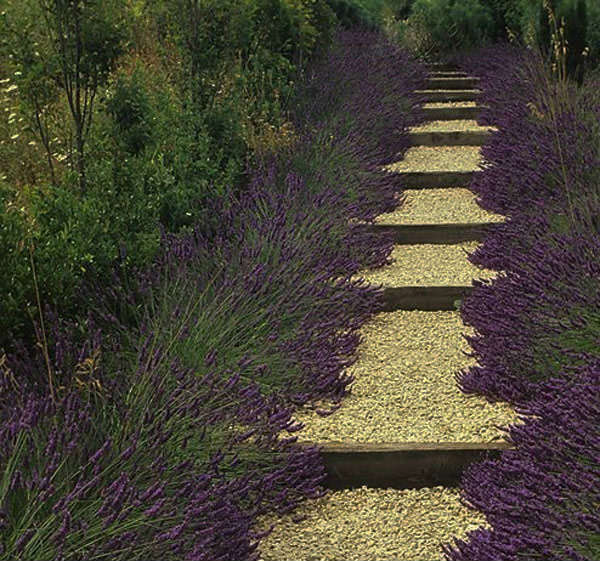

They will look great various varieties cereals You can plant low-growing shrubs such as boxwood, lingonberries, honeysuckle, etc. Let's not forget about the beautiful hosta!

3. Place nearby various animal figurines, clay pots, again with flowers or small stones, and jugs. Of course, all this should not interfere with walking up the stairs.

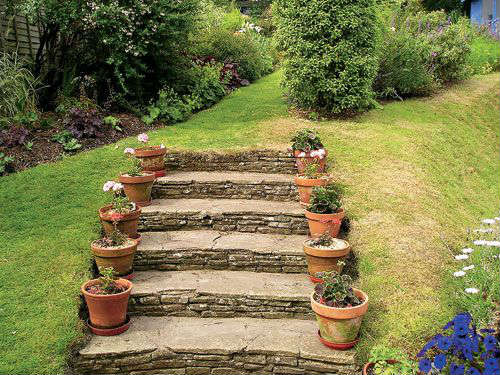
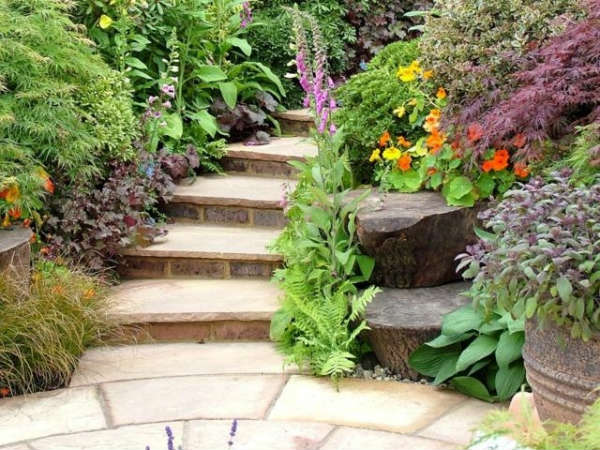
4. Decorate recreation areas with small architectural forms (statues, mini fountains). Place a bench or chair and “forget” them in a secluded place.
Sometimes on summer cottage There is a natural difference in elevation. As a rule, the owners of the site try to improve such a hillock. And the most the best option- construction of stairs. This makes walking around the site much more convenient, and provides another opportunity to create beautiful flower borders.
Such a staircase can be adapted for any area where there is at least a small slide.
You will need:
· Boards measuring 200 x 50 mm. You can take a new one construction material, but disassembled pallet stands or pallets can be used with the same success. In principle, you can take any boards that have already been used.
· Large crushed stones, stones, brick fragments.
· Slag.
· Metal fastenings.
· Screws and nails.
In addition, you will need the following tool:
· shovel;
· screwdriver;
· building level;
· saw.
Please note that the proposed staircase construction option excludes the concreting stage. And this significantly reduces the cost and simplifies the entire process.
Step #1
The photo (see above) shows a staircase with a step width of 1.2 m. The length of the sides will vary depending on the depth of the staircase bend. In this case, the length of the outer edge will always be greater than the inner one.
We will not need a foundation here, but the excavation stage is not excluded. So, let's begin. It is necessary to remove the layer of earth at the site of the first step, forming a flat platform.

Step #2
Now you can start assembling the mold for the step. Here you only need to decide on the size. Do not forget that the depth (pitch) of the step and its length must be the same for all workpieces. Otherwise, the staircase will look sloppy.
Only the opposite sides of the stage blank box will be different - internal and external. Because they are the ones who form the beautiful curve of the staircase.
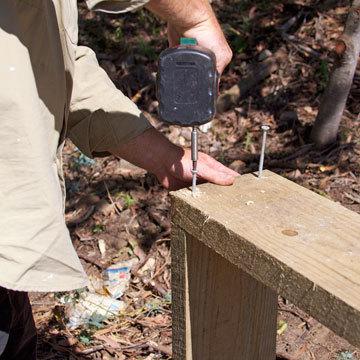
Do not forget to carry out preventive treatment of wooden step boxes against rotting. Here you can purchase specialized preparations or paint, or you can also use improvised means, in particular, drying oil or used machine oil (at least inside the box).
Step #3
Now you can start assembling the ladder. The lower stage is set first. It should have a slight slope so that rainwater did not accumulate on the steps.
You can control this stage of work using a building level.
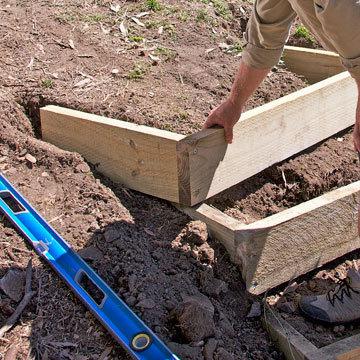
We continue to work, digging niches in the ground for each step individually (see photo). This way, you will take into account the slope of the site and be able to create the necessary curvature.
But under no circumstances change the height of the steps, as this will make walking up the stairs uncomfortable.
Step #4
After all the steps have been set, they must be secured. To do this, fix the frame of each step in the places of contact with each other using cutting boards (inside the staircase boxes).

The board must be fastened in four places (in all corners) to ensure maximum rigidity.
Step #5
To prevent the ladder from moving during operation, it must be well secured.
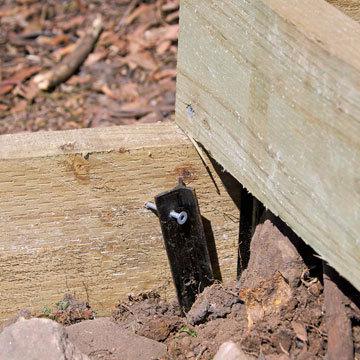
Long metal plates with a hole for fastening (see photo) need to be driven deep into the ground. We fix the upper part with a screw.
We use this type of fastening in several places for each step box.
Step #6
Now that the staircase frame is assembled and fixed, you can begin filling it.
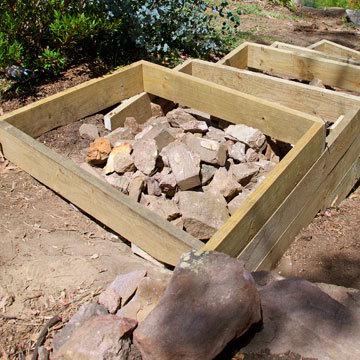
Large stones are laid out first (you can take a brick). It is desirable that they be hard and not crumble.

We do not fill the boxes completely. Leave a few centimeters of free space at the top.
Step #8
Now the slag layer needs to be compacted thoroughly.
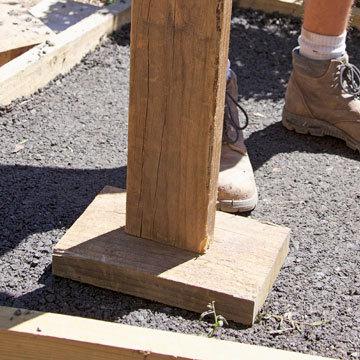
You can use a hand roller if you have one. Or you can build a device - a “pusher” as in the photo.
Step #9
Now we fill the degree form to the end, using granite chips, coarse sand, you can add a little clay to it.
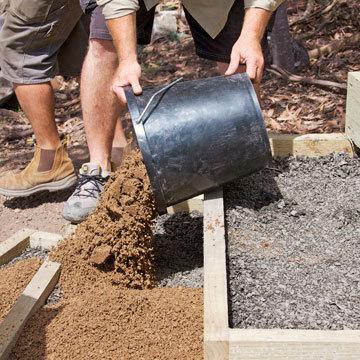
We level the layer with a spatula and finally spray the steps with water using a sprinkler.
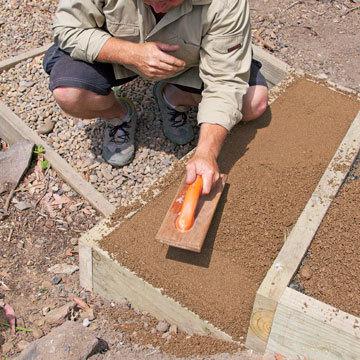
It is difficult to do without steps for ascent and descent when the home is located on a slope. It is important that they are decorative elements that harmoniously fit into the landscape of your dacha.
To construct a staircase, you must first select soil on the slope by making steps. Then install strings made from boards on the sides.
Protect the earthen steps at the front with wooden risers. Such a staircase is intended for personal use, and the strings with risers can be made from any wood, but better - from aspen or larch, which are resistant to rotting. When using wood of other species, pre-treat it with a protective agent against rotting - an antiseptic.

Scheme for manufacturing steps of a staircase designed for one pedestrian.
To fix risers in vertical position Drive sharpened pegs made of bars with a cross-section of 50x50 mm into the ground and fasten them with nails, preferably stainless steel. The pegs should be 2.5 times longer than the height of the riser.
Fill the gaps formed behind the risers with soil and compact it well.
On final stage When making the stairs, lay the treads. For this you can use gravel, finely chopped tree bark, paving stones and even turf.

Staircase made of natural stone. Characteristic for alpine slide plants make its contours softer and more natural.
Tree trunks can be used as steps, which will add “naturalness” to the staircase. Even more practical are steps made from used railway sleepers.
THE MAIN THING IS RELIABILITY!
Please note that if the stairs are too steep, climbing them will be tiring, and on very flat ones you can slip. Experience so far
stipulates that risers should have a height of 100 to 125 mm. The treads must be made at least 300 mm deep so that when descending from the stairs the foot rests completely on them and the heel does not touch the edge of the step located above.
As for the width of the stairs, for one person it should be at least 60 cm, and for two - at least 1.5 m, which guarantees convenience and safety.


